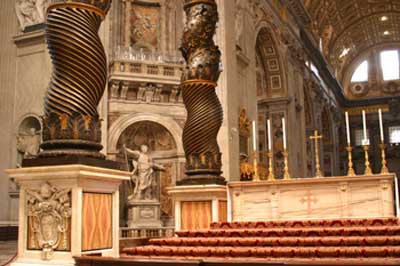Irving
Lavin in his book Visible Spirit: The Art of Gianlorenzo
Bernini, Volume 3, The Pedestals of the Baldacchino: Footsteps
on the Way to Redemption, states the following.
References to the tribulations and joys of childbirth were
understood as the labor and sufferings of the Mother Church in
bringing about salvation through a healing of the souls by
virtue of Christ's sacrifice at the crucifixion, reenacted in
the Eucharistic sacrifice of the mass.
The pedestals of
the baldacchino incorporate, as cornerstones the two stones,
Peter and Mary, on which Christ built his church. Following the
words about childbirth in the Book of Revelation and from
Christ's own mouth as reported by St John, the tribulations and
ultimate jubilation of childbirth depicted on the pedestals
reenact the process of salvation that is achieved in the
sacrifice at the altar and triumphs with the Resurrection of
Christ in the original plan for the Baldacchino, and with
the world dominion of the Cross as it was executed. The Original
Sin over which the church triumphs and from which the repentant
sinner is redeemed is illustrated in the satiric, indeed
devilish masks that appear as if imprisoned at the groins of the
cartouches.
The Chastity of Bees
Spiritual betrothal and the laborious creation of its progeny is exactly what is emblematized in the pedestals of the
Baldacchino: the birthing that takes place in the embrace of the papal arms, with the expressive heads above, the bees
marking the breast and belly in the swollen torso, and the groin covered or replaced by the ghoulish masks that echo the
goatskins with which, in the Lupercalia, pagan women were lashed at their groins to insure fertility. This increase in the
faithful through conversion and baptism is precisely the kind of progeny envisaged by Methodius and other churchmen as
resulting from the travails of the apocalyptic Woman clothed in the Sun, and Christ's own procreative passing from his death
to his Second Coming - a troubled birth with a happy issue. This construct of the ideology of the Church depends wholly on
the virginity of Mary, which is expressed in the Barberini coat of arms by the bees.
|

The Papal
Altar, Baldacchino and the Coat of Arms on the pedestals
The masks
below the coat of arms
|